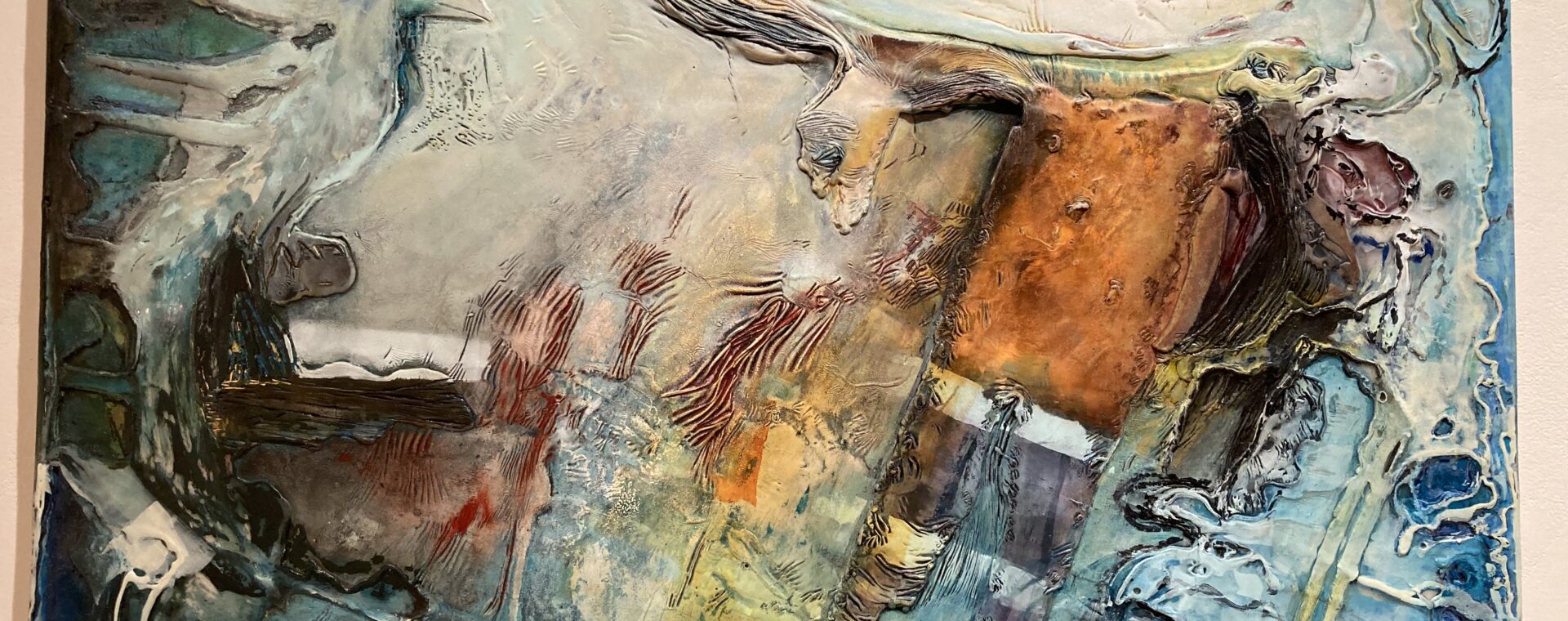An Interview with Monmouth University Professor and Artist Karen Bright
Artist and Graphic Designer, Karen Bright, Professor Emeritus, Monmouth University, exhibited her sublime vision of Planet Earth’s Second Ice Age in an exhibition entitled, Within the Anthropocene, which included encaustic paintings, mixed media sculpture, and scientific graphics, in the Center for the Visual Arts (CVA) Gallery at Brookdale Community College during the Fall, 2023 semester.
The exhibition included a powerful series of post-Sandy infographic prints derived from data sourced from organizations such as the National Oceanic and Atmospheric Administration (NOAA), NASA, and the United States Naval Observatory. These prints serve as a stark representation of climate change, its regional legacy, and its impact on our planet. Two of Karen Bright’s paintings included in the exhibition, After the Elephants and Monarch, delve into issues related to mass extinctions driven by human activities, addressing the urgent need to protect biodiversity. Additionally, her sculptural series – Still Water, created specifically for this exhibition – explores the multifaceted nature of water, both as essential giver of life and as primary player during extreme weather events. The exhibition provided visitors with a space for reflection and contemplation about the challenges our world faces in the 21st century, including climate change, biodiversity loss, and the Anthropocene epoch. It encouraged viewers to expand their imagination and consider new, sustainable interrelationships between humans, nature, and our planet.
Marie Maber, Professor of Art at Brookdale Community College interviewed the artist.
Marie: Are we meant to feel that the Earth will be better off without human habitation?
Karen: I feel the planet earth will be just fine. It’s all of us living on earth that will be, in the end, compromised. If we are not here, alive, the earth itself will regenerate itself into whatever form it needs to be given its current state of reality at that time.
Even so, it’s the non-human inhabitants of the earth—the animals, small creatures, birds, forests, and ocean life that will be irreparably affected by climate change.
We also need to remember the poor countries, those with little of the infrastructure that has caused global warming—who are also suffering major effects to their lives and homes. Look at the rising tides, tsunamis, and tidal waves that have occurred. It is entirely disproportionate. They are all impacted by our abysmal response to global warming. Mother Earth has been speaking to us, with her rising tides; her once in a lifetime storm now every decade or more. The wildfires in Canada and the Pacific Northwest—she is speaking to us. She has been and is trying to get our attention, to extract an appropriate response. The rising atmospheric temperature is terrifying and difficult to imagine getting even worse.
So, the short answer is, yes, the planet earth would be much better without human inhabitants.
Marie: One of our architecture students, Sophie, wrote about this show, “There is a sense of existential dread required to properly experience the exhibit in full.”
Karen: Sophie has spoken the truth. If one does not approach the exhibit with some kind of inherent awareness or concern of how climate change will affect their future, they will just leave scratching the surface of the narrative and message. Their takeaway will exist in the shallow—experiencing just pretty colors and unique three-dimensional forms, at best.
Karen: “Messages from the future” force you to confront oncoming realities that are so easy to otherwise be distracted by. We are a busy lot, us humans. We tend to ourselves and those we love, we shop, cook, pay bills, raise families, care for family elders (if we are so lucky), pursue dreams, build careers. There is little time or bandwidth to devote to the existential questions or our time.
My intent here is to remind, to suggest, to connect, to accomplish—small changes in mindset.
I will keep building the exhibit and creating new pieces. Often artists are given the opportunity to provide the final word on a review of their show. What would you like to say? First, I want to say “Thank-you!” to you Marie, for having the original vision in bringing my work to Brookdale. I also want to thank Elisa Elorza, for helping me every other step along the way. This exhibit inspired me to no end (generally any kind of hard deadline does). It led me to create the Still Water sculptures, which represents for me, a revelation in approach to form and materials. In their dimensionality, they are a critical new way for me to communicate. I am not an artist that can stick with the same techniques repeatedly. I never have been.
The paintings are more terrifying in my view. They attract the viewer through color and dynamic composition; if they stick with it long enough (Sophie’s point) they will get to the heart of it. The sculptures use beauty to reign one in with attractive form and texture, surprise, and color. They have magical qualities. My approach here is to get viewers’ attention through beauty. Respect the earth. Love the earth and everything Within it. The graphic diagrams use facts and data messaging more directly, but with a re-framing of how we ask the hard questions.
Messages from the Future use the personal, the emotional (giving)—to connect. In all actuality, my intent has been the same my entire career, no matter the approach, what I want to convey or perhaps, protect, has not changed. I see my role as that of a messenger. One might ask what is overarching goal? It is simply getting the public to protect and care about all living things. All living things deserve the best existence. The best legacy. Happiness for all. Preserve, protect, it’s all in the Constitution.
Marie: Have you come away with any new wisdom regarding the presentation of images and documentation of humanity’s failure to protect planet Earth?
Karen: Perhaps, my takeaway is an even greater sense that we have not met the challenge that global warming presents. That my efforts to create visual art to promote greater awareness and action for climate change and global warming is so sorrowfully—not enough. It will never be. Consider the parable of the drowning man: God sends a canoe, a motorboat, and a helicopter to save a drowning man from rising flood waters; each time the man refuses help, stating God will save him. In the end the man drowns and when he gets to Heaven, he asks God why he didn’t save him. God says, I sent you two boats and a helicopter, what more do you want from me? I feel that Mother Earth has been sending us messages, and we have not listened, are not listening, and will never listen enough. We will never meet the hard deadline.
Marie: Do you believe that with efforts to reverse the pollution in the world’s ocean, rivers, drinking water, and ecosystems, we will turn the tide on the devastating effects of pollution?
Karen: I am glad for all the efforts to curb pollution. But I fear it is too late to have much impact. That being said. During Covid when the world stopped commuting, the atmosphere cleared up, in key cities, very quickly for a time. So, the earth has some resilience. But the extent we all would need to adjust our lives to curb the effects of pollution, rising tides and rising temperatures—will take many more Covid shutdowns. It’s not a bad idea. A shutdown for the planet. Are the international climate summits making an impact on the reversal of the effects of climate change worldwide? It is promising. I am glad they are taking place.
Karen Bright’s interview and her solo exhibition Within the Anthropocene are a powerful reminder of our collective responsibility to safeguard the planet and foster a sustainable coexistence between humans, nature, and Earth. The art becomes a catalyst for introspection, challenging us to heed the messages from the future and act decisively to protect the legacy of all living things.
 Bookstore
Bookstore  Self Service
Self Service  Video Library
Video Library 
